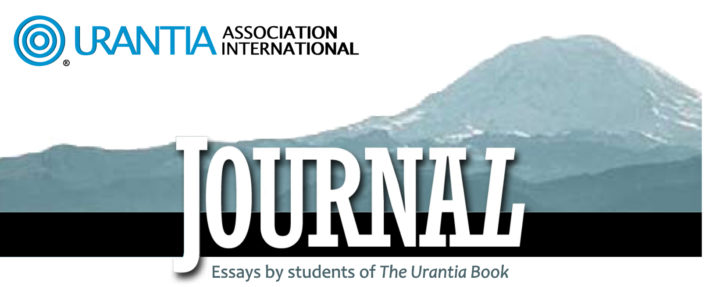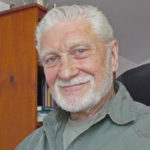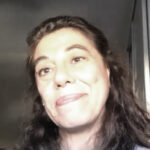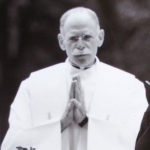© 2023 Mark Blackham, Helena Bañas, Zshonette Reed, Mamadou Doudou Diagne, Christopher Ross
© 2023 International Urantia Association (IUA)

¶ In This Issue
- Journal Editorial – May 2023 – Mark Blackham, Canada
- Getting To Know Ourselves Better – Helena Bañas, Spain
- The Ideological Struggle – Zshonette Reed, USA
- Birth of the Spirit and Spiritual Maturity – Mamadou Doudou Diagne, Senegal
- My Lord and My God! – Christopher Ross, USA
- The Next Life – Mark Blackham, Canada
- About the Journal
¶ Journal Editorial – May 2023
Mark Blackham, Canada

Welcome to the May 2023 edition of the Urantia Association’s Journal, a publication dedicated to the thoughts, observations, and experiences of Urantia Book students from around the world. Our contributors explore a wide range of topics relating to the fifth epochal revelation, demonstrating both an extraordinary diversity of thought and a spirited unity of purpose.
Our first article has to do with the fascinating interface between science and religion. “Getting to Know Ourselves Better: The Neurophysiological Basis of Self-Control” by Helena Bañas, a medical doctor, explores the nature of the brain and consciousness in relation to the spiritual forces operating within the mind. In particular, she underscores how the power of personality, in conjunction with the inner Spirit, can actually change the physical structure of the brain, a process known as neuroplasticity.
Helena explains that we consciously create physical changes in ourselves, for better or worse, by means of habitual processes, such as making repetitive decisions, and by giving our concentrated attention to a particular concept. But the real secret of positive self-control and, therefore, beneficial change to brain structure, is achieved by tapping into the power of the inner spirit through acts of love and worship.
¶ Getting To Know Ourselves Better
Helena Bañas, Spain
The Neurophysiological Basis of Self-Control

This article deals with self-mastery, that ability that allows us to manage our emotions and instincts; to “respond” to them instead of “reacting,” which is key to “emotional intelligence,” a term popularized by the American psychologist, Daniel Goleman, in the 1990s.
One quote from The Urantia Book says that “emotional maturity is essential to self-control” (UB 52:6.6) and another is that “the manifestation of greatness on a world like Urantia is the exhibition of self-control” (UB 28:6.20). Thus, greatness would be synonymous with emotional maturity. A good start to achieving this goal is to know ourselves better. Understanding the functioning of our nervous system (NS) can help us to adjust our behavior.
The Urantia Book contains within its pages the true “keys” to achieve this self-mastery and contributes to science that which it cannot discover by itself; that which is invisible and enigmatic. It reveals to us who we really are.
By this, I mean that science attributes the ability for self-regulation, or self-control, to our brain, and establishes that it is the seat of our emotions, behavior and thoughts. But this runs into the classic mind-brain “problem,” or the difficult problem of consciousness, for which neuroscientists and philosophers cannot find a true explanation and end up calling it a “mystery.”
¶ The Ideological Struggle
Zshonette Reed, USA
¶ Part 1 | Taking a Stand
In the Publication Mandate for The Urantia Book, we are told that we must have an army of teachers and leaders at the ready for a grand educational work after the conclusion of the present ideological struggle. We believe this struggle is the same struggle raised by the Lucifer Rebellion – that is, true liberty versus false liberty, or liberty versus license.
While the rebellion was crushed by Michael upon the successful completion of his bestowal mission, the effects of the rebellion remain. And this residual effect is why we continue to experience the ideological struggle on our world. If we are correct that this struggle is the struggle between liberty and license as presented by the Lucifer Rebellion, then it is imperative that we take our stand on the right side of the struggle.
¶ Is it Necessary for Us to Take a Stand?
Since the struggle is celestial in origin, maybe it’s up to celestials to resolve it. Maybe all we need to do is be good people and work on our own personal relationship with the Father. As The Urantia Book explains, Michael chose to remain aloof from the rebellion until he completed his bestowal mission. In fact, that was the counsel given to him from the Paradise representatives. But this does not imply that others who support Michael should remain aloof. Let’s look at the record.
¶ Birth of the Spirit and Spiritual Maturity
Mamadou Doudou Diagne, Senegal

I would like to share some ideas, as an introduction to a discussion, around this subject that unites us: "Being born of the Spirit and Spiritual Maturity.” It is about this human experience, so personal and singular, between every person and God.
Birth indicates the starting point of existence. To be born is to have an impulse, a life force, which inaugurates our coming into the world. And it continues and is expressed in biological and cultural life, through the succession of days, until the point of arrival - death.
As far as maturity is concerned, it shows the completion of a process of growth and satisfactory evolution, whether it be physical, intellectual, moral, or spiritual. Analogously, it is also the state of fruits, when they are ripe, after having reached their full development.
This small conceptual reminder allows us to better approach our theme, which relates two facts, which are birth and maturity, in relation to Spirit. We can say that the Spirit is the opposite of matter, that is, that which is placed within us, beyond̀ material or physical reality, but also its source, God, our Perfect Creator and our Finality.
¶ My Lord and My God!
Christopher Ross, USA

In the mid 1990’s, I worshiped at an Episcopal church in New York’s Greenwich Village. Taking the same pew week after week, as most people do, I often found myself sitting near an older woman named Barbara. Each week during the prayer of consecration, when the priest said, “Take this, all of you, and eat it: this is my body which will be given up for you,” he or she raised the host for all to see. The congregation, in response, made the sign of the cross. Barbara did that too, but invariably I also heard her whisper something. Likewise, when the chalice was raised, we made the sign of the cross and Barbara whispered something.
An imposing woman in her late seventies, Barbara had been very active and influential in the parish for many, many years. Her formality and her position on the Vestry rendered her completely unapproachable, exacerbated by her austere features and her hair, which I am convinced she kept in the freezer. More important, I did not want to appear ignorant or stupid or just plain nosy. I was relatively new to the church—a “baby Episcopalian,” as the Rector called me—and I didn’t want anyone to know how little I knew, even though I neither saw nor heard anyone else whispering. Therefore, instead of simply asking Barbara what she was mumbling under her breath, I tried each week to sit closer and closer to her, straining to hear what she was saying during the elevation of the elements. Thinking about it now, I wonder what Barbara thought was happening, as each week I seemed to be more and more interested in her!
¶ The Next Life
Mark Blackham, Canada
“In my Father’s house are many mansions;
if it were not so, I would have told you.” – Jesus
Now that I’ve reached the age of 73, my interest in the next life and the morontia worlds has become more acute. But of all the 56 morontia worlds surrounding Jerusem—the headquarters world of the Satania system—my attention is drawn more so to the seven satellites surrounding transition world number one (the finaliters’ world). These are the mansion worlds, and this is where our eternal journey resumes after we leave Urantia, our “initial-life” planet.
The mansion worlds are but a small part of the Jerusem system of architectural worlds, as you can see from the diagram below. Transition world number one and its surrounding mansion worlds is only one of seven transition worlds with their own satellites. Jerusem itself is a gigantic world, about one hundred times the size of Urantia, which is almost the size of our sun. The transition worlds are about ten times the size of earth, close to the size of Saturn or Jupiter. And each of the mansion worlds and all other satellites are approximately the size of Urantia (UB 45:0.1).
¶ About the Journal

The Journal is produced twice yearly and contains essays, articles and study aids by readers and for readers of The Urantia Book. Any interpretations, opinions, conclusions, or artistic representations, whether stated or implied, are those of the authors and do not necessarily represent the views and opinions of Urantia Association International, the National or Local Urantia Associations, or the editorial team of the Association’s Journal.
You can view the entire collection of issues in the archives. All issues before 2017 are downloadable PDF format.
The Journal is currently published in English, French and Spanish. (There are some older issues that were published in Finnish) You can view the French and Spanish Journals by clicking on the language choices in the pull down menu at the top of the page.
- Subscriptions
- Journal Team
- Submission Policy
- Citation Guidelines